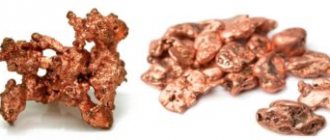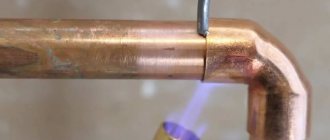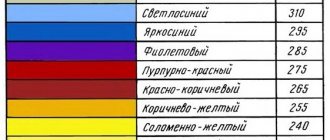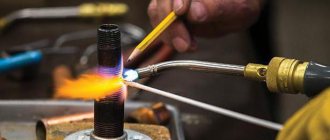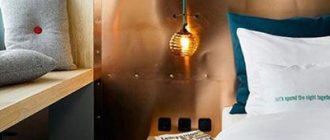Gas equipment is an unsafe device. Therefore, it is necessary to know the signs of various breakdowns in order to quickly eliminate them. The most common cause in gas equipment is a change in the color of the gas combustion. Normally it should be blue. But if you notice that the color has turned red, orange or yellow, and an unpleasant odor has appeared and black soot is falling, then most likely the fire is smoking. If injection is disrupted, orange or yellow colors appear on the flames. This indicates a lack of air.
In our article we will talk in detail about gas combustion and the signs of poor performance of gas equipment.
Colored candles
To get candles with multi-colored flames, you need to add a metal salt to the molten paraffin, which colors the flame in one color or another.
Blue candle . Paraffin can be colored blue with copper stearate. This salt is obtained by mixing solutions of copper sulfate and laundry soap. The candle flame will also be blue, thanks to copper ions.
Green candle . Green chromium(III) oxide is used as a pigment. It is obtained by the thermal decomposition of ammonium bichromate (volcano experiment). The flame color will also be green.
Yellow candle . Yellow sodium chromate will turn paraffin and candle flames yellow.
Red candle . Paraffin can be tinted with any red pigment, such as gouache. To make the flame red, you need to add some strontium or lithium salt.
Bibliography
- Krzysztof Kuszmierczyk, magazine "Horizons of technology for children" 1989-3
The correct color of gas combustion is blue
In order for the gas to burn completely and release the maximum amount of heat, a sufficient amount of air is needed. It is mixed with gas in the burner in the required proportions. Thus, high intensity of heating and heat release will be ensured. If there are any obstacles to the flow of air, the gas does not burn completely and carbon monoxide is released. And the flame turns yellow.
The heating of the coolant and the color of the flame depend on the amount of air supplied. If the right amount of air is supplied, the color of the flame turns blue.
If the air-fuel mixture contains more gas than air, the flame may turn yellow. And after some time it may even turn red or white. This is due to the increased gas supply to the main burner. In this case, incorrect fuel consumption occurs and the burner begins to smoke. If the burner smokes, it will not heat the water, the boiler will not heat the coolant well, a black mark from the gas stove will be left on the dishes, and thus the food will be saturated with sulfur.
Experiments: Colored flame
Secrets of Mad Professor Nicolas
A very beautiful scientific experiment from Professor Nicolas, “Colored Flames,” allows you to create flames of four different colors using the laws of chemistry.
The set is most interesting, we really saw enough of the flames, an amazing sight! It’s interesting for everyone: both adults and children, so I highly recommend it! The advantage is that this experiment with fire can be done at home, you don’t have to go outside. The set includes bowls in which a tablet of dry fuel burns, everything is safe, and can be placed on a wooden floor (or table). From a series of experiments by Professor Nicolas.
It is better, of course, to conduct the experiment under adult supervision. Even if the children are already quite big. Fire is still a dangerous thing, but at the same time... creepy (this word fits perfectly here!) interesting!
See photos of the set packaging in the gallery at the end of the article.
The 'Colored Flame' kit contains everything you need to carry out the experiment. The set includes:
- potassium iodide,
- calcium chloride,
- hydrochloric acid solution 10%,
- copper sulfate,
- nichrome wire,
- copper wire,
- sodium chloride,
- dry fuel, evaporation cup.
The only thing I have some complaints about the manufacturer is that I expected to find a mini-brochure in the box describing the chemical process that we are seeing here and an explanation of why the flame becomes colored. There is no such description here, so you will have to turn to the encyclopedia on chemistry (review of books on chemistry here). If, of course, there is such a desire. And older children, of course, have a desire! Younger children, of course, do not need any explanations: they are simply very interested in watching how the color of the flame changes.
On the back of the packaging box it is written what needs to be done to make the flame become colored. At first they did it according to the instructions, and then they just started sprinkling the flames with different powders from jars (when they were sure that everything was safe) - the effect was amazing. Flashes of red flame in yellow, bright light green flame, green, violet. the spectacle is simply mesmerizing.
It’s very cool to buy for some holiday, it’s much more interesting than any firecracker. And it will be very great for the New Year. We burned during the day; it would have been even more spectacular in the dark.
We still have the reagents left after burning one tablet, so if we take another tablet (purchase separately), we can repeat the experiment. The clay cup washed quite well, so it will be enough for many experiments. And if you are at the dacha, then you can sprinkle the powder on the fire in the fire - then, of course, it will quickly end, but the spectacle will be fantastic!
I am adding brief information about the reagents that come with the experiment. For inquisitive kids who are interested in learning more.
Flame coloring
The standard method of coloring a faintly luminous gas flame is to introduce metal compounds into it in the form of highly volatile salts (usually nitrates or chlorides):
red - strontium, calcium,
green - cesium (or boron, in the form of boronethyl or boronmethyl ether),
blue - copper (in the form of chloride).
Selenium colors the flame blue, and boron colors the flame blue-green.
The temperature inside the flame is different and changes over time (depending on the influx of oxygen and combustible substance). Blue color means that the temperature is very high up to 1400 C, yellow means the temperature is slightly lower than when the flame is blue. The color of the flame may vary depending on chemical impurities.
The color of a flame is determined only by its temperature, if you do not take into account its chemical (more precisely, elemental) composition. Some chemical elements are capable of coloring a flame in a color characteristic of that element.
In laboratory conditions, it is possible to achieve a completely colorless fire, which can only be determined by the vibration of the air in the combustion area. Household fire is always “colored”.
The color of a fire is determined by the temperature of the flame and what chemicals it burns. The high temperature of the flame allows atoms to jump to a higher energy state for some time. When the atoms return to their original state, they emit light at a specific wavelength. It corresponds to the structure of the electronic shells of a given element.
blue _
the flame, for example, that can be seen when natural gas burns, is caused by carbon monoxide, which gives the flame its hue. Carbon monoxide, a molecule made up of one oxygen atom and one carbon atom, is a byproduct of the combustion of natural gas.
Potassium - violet flame
Potassium (German Kalium, French and English Potassium) is one of the most important representatives of the group of alkali metals.
Potassium is the most electropositive metal after rubidium and cesium. In clean dry air at ordinary temperature it does not change, in ordinary air it is covered with a layer of caustic potassium and carbon dioxide of its salt; in a fresh cut it glows in the dark, but in thin plates it oxidizes so quickly that it can catch fire; molten and heated, it also burns; its flame is violet in color. Due to this tendency to oxidize, it is necessary to store it under oil.
The presence of potassium is discovered by the violet color of a colorless gas flame, which is obtained when its compounds, especially halogen compounds, are added to the flame on the eye of a platinum wire (this is why in the experiment it is necessary to add potassium to the flame on a wire - the effect of changing the color of the flame is then more noticeable)
; in the presence of sodium salts, the color is observed through cobalt blue glass or through an indigo solution placed in a prismatic glass vessel. The flame spectrum is characterized by two lines - red and violet.
Calcium chloride - red flame
When heated in air or oxygen, calcium ignites and burns with a red flame with an orange tint. Calcium reacts with less active non-metals (hydrogen, boron, carbon, silicon, nitrogen, phosphorus and others) when heated.
When soluble calcium salts are added to the flame, the flame turns brick-red.
When heated in oxygen and air, calcium ignites, burning with a bright red flame, forming the basic oxide CaO, which is a white, highly fire-resistant substance with a melting point of approximately 2,600 °C. Calcium oxide is also known in engineering as quicklime or burnt lime.
Hydrochloric acid and copper - green flame
Copper gives the flame a green tint. With a high copper content in the combustible substance, the flame has a bright green color, almost identical to white. The flame is colored green by boric acid or copper (brass) wire dipped in hydrochloric acid.
When wetted hydrochloric
acid the flame
turns blue with a greenish tint.
1) In green
The color
of the flame
is colored by boric
acid
or copper (brass) wire dipped in
hydrochloric acid
.
The flame turns red
colors chalk soaked in the same
hydrochloric acid
.
When strongly calcined in thin fragments, Ba-containing (Barium-containing) minerals color the flame yellow-green. The coloring of the flame can be enhanced if, after preliminary calcination, the mineral is moistened in strong hydrochloric acid.
Copper oxides (in the green flame experiment, hydrochloric acid and copper crystals are used)
give an emerald green color. Calcined Cu-containing compounds moistened with HC1 color the flame azure blue (CuC12). The reaction is very sensitive.
Barium, molybdenum, phosphorus, and antimony also give green color and its shades to fire.
Copper nitrate and hydrochloric acid solutions are blue or green; When ammonia is added, the color of the solution changes to dark blue.
Yellow flame - salt
A yellow
flame
requires the addition of table
salt
, sodium nitrate or sodium chromate.
Try sprinkling a little table salt on the burner of a gas stove with a transparent blue flame - yellow tongues will appear in the flame. Such a yellow-orange flame
give sodium salts (and table salt, remember, is sodium chloride).
Yellow is the color of sodium in the flame. Sodium is present in any natural organic material, which is why we usually see yellow flames. And yellow color can drown out other colors - this is a feature of human vision.
Yellow flames appear when sodium salts decompose. Wood is very rich in such salts, so an ordinary forest fire or household matches burn with a yellow flame.
Gas lights up yellow or orange
An imbalance in the air-fuel mixture occurs for various reasons. The air intake holes may be clogged with dust particles. This creates an obstacle to the passage of air. Gas equipment is most susceptible to plaque in the first year of use. Since after stamping, the ignition group tube and the burner retain an oil film for some time. Therefore, dust sticks and prevents air from passing through, but gas passes through perfectly. There is a large supply of gas to the burner. And the balance is upset when mixing the fuel supply to the burner.
Consequently, the gas enters with dust and soot, which is why the yellow and orange color of gas combustion occurs.
Another main mistake is purchasing gas equipment for a different type of gas. After all, if you use one gas, and your equipment is designed for another, then the yellow color of gas combustion appears.
In a gas stove, the air control valve may fall, jump off, or be closed. Thus, the required amount of air does not flow. If there is not enough oxygen, then not all stoves can burn with electric ignition and have a blue flame. Many people save and lose heat. In this case, it is necessary to repair the gas stove.
What to do in such a situation
Once the color of the flame turns orange, red or yellow, you should understand that this indicates danger. Therefore, it is necessary to find the problem and fix it. Once you notice a change in the color of the flame, you should contact a qualified specialist to diagnose and repair the gas device.
It may be necessary to clean the gas equipment, replace the burner nozzles and adjust the air seal in the boiler. You can adjust the air-fuel mixture yourself. This does not require the help of a specialist.
The main requirement before installing gas equipment is the installation of carbon monoxide detection sensors.
It will not be difficult for qualified specialists to eliminate flame smoke. This does not require special tools. If you have the slightest suspicion of a carbon monoxide leak, immediately contact a specialist.
Flame color
It is not difficult to guess that the hue of a flame is determined by the chemicals burning in it, if exposure to high temperature releases individual atoms of the combustible substances, coloring the fire. To determine the effect of substances on the color of fire, various experiments were carried out, which we will discuss below.
Since ancient times, alchemists and scientists have tried to find out what substances burn, depending on the color that the flame acquires.
The flames of gas water heaters and stoves, available in all houses and apartments, have a blue tint. When burned, this shade is produced by carbon, carbon monoxide. The yellow-orange color of the flame of a fire that is lit in the forest, or of household matches, is due to the high content of sodium salts in natural wood. This is largely due to the color of the fire truck being red. The flame of a gas stove burner will acquire the same color if you sprinkle it with ordinary table salt. When copper burns, the flame will be green. I think you have noticed that when you wear a ring or chain made of ordinary copper that is not coated with a protective compound for a long time, the skin becomes green. The same thing happens during the combustion process. If the copper content is high, a very bright green light occurs, almost identical to white. This can be seen if you sprinkle copper shavings on a gas burner.
Many experiments have been carried out using an ordinary gas burner and various minerals. In this way their composition was determined. You need to take the mineral with tweezers and place it in the flame. The color that fire takes on can indicate the various impurities present in the element. A green flame and its shades indicate the presence of copper, barium, molybdenum, antimony, and phosphorus. Boron produces a blue-green color. Selenium gives the flame a blue tint. The flame turns red in the presence of strontium, lithium and calcium, and violet in the presence of potassium. The yellow-orange color is produced when sodium burns.
Studies of minerals to determine their composition are carried out using a Bunsen burner. The color of its flame is even and colorless; it does not interfere with the course of the experiment. Bunsen invented the burner in the mid-19th century.
He came up with a method that allows one to determine the composition of a substance by the shade of the flame. Scientists had tried to conduct similar experiments before him, but they did not have a Bunsen burner, the colorless flame of which did not interfere with the progress of the experiment. He placed various elements on a platinum wire into the burner fire, since when this metal is added, the flame does not become colored. At first glance, the method seems good; labor-intensive chemical analysis can be dispensed with. You just need to bring the element to the fire and see what it consists of. But substances in their pure form can be found extremely rarely in nature. They usually contain large quantities of various impurities that change the color of the flame.
Bunsen tried to highlight colors and shades using various methods. For example, using colored glass. Let’s say that if you look through blue glass, you won’t see the yellow color that fire turns when burning the most common sodium salts. Then the lilac or crimson shade of the desired element becomes distinguishable. But even such tricks led to the correct determination of the composition of a complex mineral in very rare cases. This technology could not achieve more.
Nowadays, such a torch is used only for soldering.

